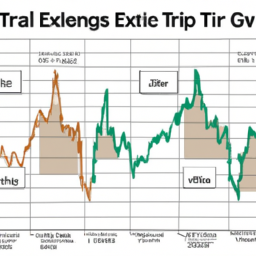Exchange-Traded Funds (ETFs) have become increasingly popular for investors looking for an alternative to roiling equity markets. An ETF is a type of investment fund that tracks a specific index, such as the S&P 500, or a sector, such as the technology sector, and is traded on a stock exchange. ETFs offer investors the potential to diversify their portfolios, as they can invest in a wide range of assets, including stocks, bonds, commodities and currencies.
ETFs can be compared to mutual funds, which are also types of investment funds, but they differ in a few key ways. ETFs are traded on exchanges, while mutual funds are bought and sold through fund managers. ETFs are also more tax efficient than mutual funds, as they are not subject to capital gains taxes until the ETF is sold. Mutual funds, on the other hand, are subject to taxes at the end of the year.
When it comes to ETFs, there are a few popular options available. The SPDR S&P 500 ETF (AMEX:SPY) and the Vanguard 500 Index Fund (VFINX) are two of the most popular ETFs, and they both track large-cap U.S. stocks. Other popular ETFs include the iShares MSCI Emerging Markets ETF (AMEX:EEM), which tracks stocks in emerging markets, and the Invesco QQQ Trust (NASDAQ:QQQ), which tracks the tech-heavy Nasdaq 100 index.
In addition to these more traditional ETFs, there has been a growing interest in ETFs that focus on artificial intelligence (AI). These ETFs use AI to analyze data and make investment decisions, and they can provide investors with exposure to the fast-growing AI industry. However, there is a wide gulf between ETFs that use AI to invest and ETFs that simply track AI-related stocks.
For investors who are worried about an economic downturn, there is the Principal U.S. Mega-Cap Multi-Factor Index ETF (NASDAQ:USMC). This ETF is designed to provide investors with exposure to large-cap U.S. stocks that have demonstrated strong fundamentals, such as low volatility and high dividend yields. It is also diversified across sectors, providing investors with additional protection against market volatility.
The most popular ETFs are generally those with the highest assets under management (AUM). AUM is the total value of assets that an ETF holds, and it is a good indicator of the fund's popularity. For example, the SPDR S&P 500 ETF (AMEX:SPY) has an AUM of over $340 billion, while the Vanguard 500 Index Fund (VFINX) has an AUM of over $80 billion.
Asset managers are increasingly looking to ETFs to provide investors with exposure to socially responsible investments. For instance, BlackRock recently announced that it will close three smaller ETFs that track Bloomberg sustainable accounting SASB indices. These ETFs are designed to track companies that are taking action on environmental and social issues, such as climate change.
There is also a growing interest in ETFs focused on India. The Nifty 50 ETF (NASDAQ:NFTY) is one of the most popular India-focused ETFs. It is the only India-focused ETF traded in North America or Europe that has managed to stay in the green despite a challenging year for the Indian economy.
Finally, it is important to understand the risks associated with ETFs. While ETFs can provide investors with exposure to a wide range of investments, they can also be subject to market volatility and other risks. It is important to research ETFs thoroughly before investing, and to seek professional advice if necessary.
